Briefing: Aviation shines at Endeavor Awards
Public Benefit flying celebrated in Los Angeles
By Julie Summers Walker
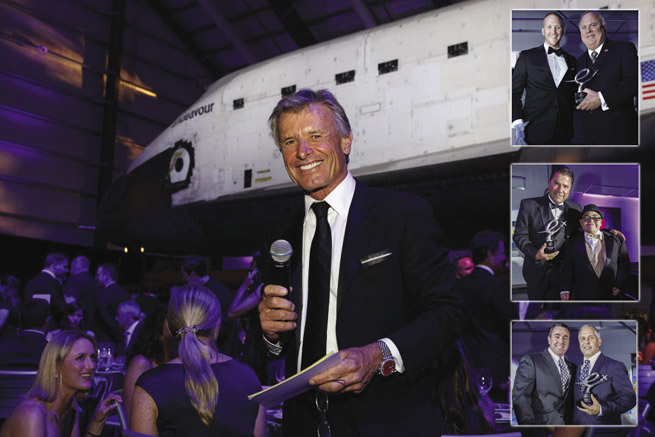
A star-studded evening at the California Science Center in Los Angeles honored those who volunteer their time and aircraft to help others. There were movie stars, astronauts, aviation industry luminaries, television actors—and, above all, the pilots and those they serve—dining under the wings of the Space Shuttle Endeavor.
The Endeavor Awards are the brainchild of Hollywood filmmaker Mark Wolper, an active general aviation pilot and himself a member of Angel Flight West, who wanted to shine a spotlight on how GA serves those in need. “It’s time to tell the world how public benefit aviation improves our world and saves precious lives,” he said.
More than 400 people attended the event, hosted by master of ceremonies Sean D. Tucker. Tucker encouraged the audience with his signature phrase, “Yah, baby!” as he announced the winners (above).
The event featured tours of the California Science Center, video presentations, an aerial dancer playing Amelia Earhart, specialty cocktails, gourmet dinner, and music from the USC marching band.
Among those in attendance were the legendary Bob Hoover, Clay Lacy, John and Martha King, and actors Edward Asner and Greg Kinear. Red Bull Airshow helicopter pilot Chuck Aaron had to cancel his appearance at the last minute. Wolper says the awards will be an annual event and has already begun planning for 2015.
For more information on the Endeavor Awards, visit the website.
Email [email protected]
Three volunteer pilots were honored at the first-ever Endeavor Awards. Jeff Hendricks, Veterans Airlift Command/Angel Flight West (top on left); Joe DeMarco Sr., Wings Flights of Hope (center); and Joe Howley, Patient Airlift Services (PALS, (bottom) joined master of ceremonies Sean D. Tucker on stage to accept their awards.
Hendricks could hardly speak as he was lauded by wounded veteran Tyler Jefferies, a double amputee. DeMarco was upstaged by his “friend and copilot” Luke, a young man with a double lung transplant. In a small tux and bow tie, Luke told the rapt audience that DeMarco was his “personal pilot and without him I wouldn’t be here.” DeMarco has flown more than 1,165 missions. Howley has been a volunteer pilot for more than 15 years (see “Flight Before Christmas,” September 2012 AOPA Pilot).
News: Rare Fairchild 71 airliner flying again
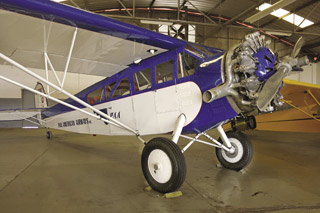 Only three Fairchild 71 aircraft were ever flown by Pan American Airways, and one of them has been fully restored and is now owned by Gary Coonan of Bell Buckle, Tennessee. The aircraft, normally hangared in Tullahoma, Tennessee, was spotted recently in Winter Haven, Florida, where weather caused a delay in its return from Sun ’n Fun in Lakeland, Florida, to Tennessee.
Only three Fairchild 71 aircraft were ever flown by Pan American Airways, and one of them has been fully restored and is now owned by Gary Coonan of Bell Buckle, Tennessee. The aircraft, normally hangared in Tullahoma, Tennessee, was spotted recently in Winter Haven, Florida, where weather caused a delay in its return from Sun ’n Fun in Lakeland, Florida, to Tennessee.
The airplane flew for a Pan Am subsidiary and served cities along the Mexican coast, making various stops along the way including Guatemala. Artfully penned logbooks document every trip ever made.
The plane cruises at 100 miles an hour and lands at 60. “Very comfortable to travel in—slow—and heavy on the controls,” Coonan said. “Flies like a giant Cub.”
When Coonan bought the aircraft in 2013 it had been completely restored, after originally being a semi-basket case, by John Cournoyer and Terry Chastain at Creve Coeur, Missouri, and was in that airport’s Historic Aircraft Restoration Museum. He replaced the engine and upholstery. Coonan said he gives rides in the aircraft just for fun and plans on taking it to several fly-ins. —Alton K. Marsh
75 years ago this month
AOPA was incorporated on May 15, 1939.
John Nance Garner is vice president of the United States. The U.S. population is 130,879,718. Skater Sonja Henie is on the cover of Time magazine. The Pulitzer Prize for fiction is awarded to Marjorie Kinnan Rawlings for The Yearling. The last remaining Jewish-owned enterprises in Germany are closed by the Nazis.
July 2: Theodore Roosevelt’s head is dedicated at Mount Rushmore.
July 4: Baseball great Lou Gehrig gives his last public speech following diagnosis of ALS. In it, he says, “Today I consider myself the luckiest man on the face of the Earth.” The Yankees retire his uniform #4.
July 13: Frank Sinatra makes his recording debut.
July 15: Clara Adams sets a record for around-the-world flight solely on scheduled passenger airlines.
July 22: Jane Matilda Bolin of New York City is named first black female judge.
July 23: Mahatma Ghandi, the spiritual leader of India, writes a personal letter to Adolf Hitler addressing him “my friend,” requesting to prevent any possible war.
July 27: The first recorded snowfall in Auckland, New Zealand, since records began in 1853.
Airport stories: Smith Field
Historic gem thriving a decade after closure threat
By Alyssa J. Miller
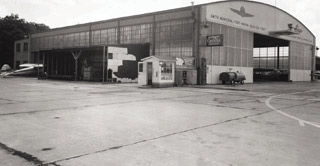 Indiana’s Smith Field, known originally as Baer Municipal, has enjoyed strong community support since its dedication in 1925, the same year it hosted an airshow that drew 50,000 spectators. Throughout the decades, Fort Wayne residents have frequented the airport, watching aircraft take off and land, having picnics, or going for flights. Despite the strong community support, the city’s mayor tried to close it in the 1970s, and the Fort Wayne-Allen County Airport Authority tried to close the field in the early 1990s. That effort was postponed by a 10-year moratorium, but as soon as it was lifted, the airport authority voted to close the field in 2002.
Indiana’s Smith Field, known originally as Baer Municipal, has enjoyed strong community support since its dedication in 1925, the same year it hosted an airshow that drew 50,000 spectators. Throughout the decades, Fort Wayne residents have frequented the airport, watching aircraft take off and land, having picnics, or going for flights. Despite the strong community support, the city’s mayor tried to close it in the 1970s, and the Fort Wayne-Allen County Airport Authority tried to close the field in the early 1990s. That effort was postponed by a 10-year moratorium, but as soon as it was lifted, the airport authority voted to close the field in 2002.
Two airport support groups, Smith Airfield Forever (SAFE) and SMD Fund, rallied the community to save the airport, convincing the airport authority to reverse its decision just months before it was scheduled to close. Residents signed petitions in favor of the airport, wrote letters to the editor, and displayed “We support Smith Field” yard signs and stickers on their cars. Multiple lawsuits were filed to keep it open, and the airfield was added to the National Register of Historic Places. AOPA’s Airport Support Network volunteer at the time, Ken Russell, was instrumental in helping AOPA work with the support groups at Smith Field. “I will not say that any one group ‘saved’ the field, but I am confident that it would not have been saved without multifaceted efforts,” Russell told AOPA via email. Russell served as AOPA’s volunteer at the field until he accepted a job with the city of Cedar Rapids, Iowa, five years ago.
Now, the airport is thriving. “We have a responsibility to keep this airport viable, and we’re going to,” said Craig Williams, director of operations for the Fort Wayne-Allen County Airport Authority. “We’re fans of GA. We grew up in GA.” A new terminal has been built, and new T-hangars have attracted tenants. The FBO and flight training provider on the field, Sweet Aviation, opened a maintenance facility less than a year ago and offers seven aircraft for rent. Ivy Tech Community College expanded its aviation maintenance technology program at Smith Field and now has a new 21,000-square-foot aviation center; aerial power line inspection and maintenance company Haverfield Aviation has a regional office based at the airport. Pilots gather for fly-outs, offer Young Eagles flights, sit at their hangars to watch takeoffs and landings, and host cookouts. Community residents picnic at a patio outside Sweet Aviation that overlooks the airfield, once again making the airport a community hub.
Email [email protected]
Sweet aviation
Two teenagers, two dreams: Andrew Griffith wants to be a missionary pilot or mechanic, Rigel Jaquish possibly an airline captain. An army of pilots and airport supporters is helping to make those dreams come true at Smith Field in Fort Wayne, Indiana. The SAFE airport support group donated a one-time $5,750 scholarship to Sweet Aviation, the fixed-base operator at Smith Field, to use to train the two teens toward their private pilot certificates. Griffith and Jaquish have completed ground school at Sweet Aviation and soon will be starting flight training. The funds were left over from donations supporting the group’s advocacy efforts to save the airport a decade ago. In a scholarship presentation earlier this year, the nonprofit group ceremonially closed the book on the effort to save the airport by investing in these students’ dreams.
Did you know
Smith Field is home to Experimental Aircraft Association Chapter 2.
Airmail and scheduled airline service began operations at the airport in the 1930s and 1940s.
During World War II, parachutes were made in the second floor of Smith Field’s Hangar 2.
Interstate Aircraft TDR-1 Assault Drones, an early twin-engine UAV, were built in Smith Field’s Hangar 2.
It’s a reliever for Fort Wayne International Airport.
Solo flight 2013: Youngest earthrounder reflects on his accomplishment
By Jolie Lucas
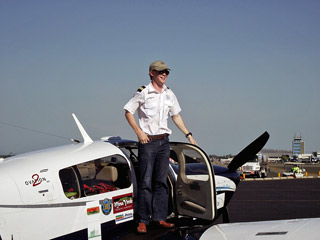 At 20 years old, Jack Wiegand began his plans for Solo Flight 2013 in an attempt to break the Guiness World Record by becoming the youngest person to fly solo around the world, in a Mooney Ovation. While Jack had excellent flight instruction and training in airplane systems and flight planning, he had no formal preparation for the psychological challenges of this endeavor. Armed with four months of training in the Mooney—N432BG—his instrument ticket, and 450 hours total time, he departed Fresno, California. He would cross time zones, international boundaries, the date line, and face many challenges. His journey highlights the pyschological qualities of daring, enthusiasm, and fortitude.
At 20 years old, Jack Wiegand began his plans for Solo Flight 2013 in an attempt to break the Guiness World Record by becoming the youngest person to fly solo around the world, in a Mooney Ovation. While Jack had excellent flight instruction and training in airplane systems and flight planning, he had no formal preparation for the psychological challenges of this endeavor. Armed with four months of training in the Mooney—N432BG—his instrument ticket, and 450 hours total time, he departed Fresno, California. He would cross time zones, international boundaries, the date line, and face many challenges. His journey highlights the pyschological qualities of daring, enthusiasm, and fortitude.
First stop
His journey from Fresno into northern Canada brought a series of firsts: first French-speaking controllers; first flight over wilderness; first flight over water; first time wearing immersion suit; first time losing radio contact.
He shot the approach into Iqaluit, Canada, with blowing snow and a gusting 30-degree crosswind. He taxied onto the icy ramp to clear customs. When asked for his papers, he handed the officer his passport case; it was empty. He had embarked on his round-the-world journey without his passport. After a frantic hour and a half search of the airplane on the dark, cold ramp, he realized he left it at home in Fresno.
“I went from the top of the world to bottom of the world in 20 minutes,” he said.
A few days of international wrangling later, he had his passport in his possession. And the story of the dashing young aviator who left without his passport made both national and international news.
As he departed for Reykjavik, Iceland, over the Atlantic Ocean, Jack began having questions about the performance of his high-frequency radio. Wearing the immersion suit, having the life raft up front, survival raft right behind, and the personal locator beacon strapped on his body were constant reminders of the risk.
His preparation had been with flight training and airplane systems and emergency procedures. Now he began to feel keenly alone, and wondered about personal safety. Coupled with sleep issues, a different diet, flight pressures, and loneliness, the young man found himself tested in ways he never would have imagined.
Taking its toll
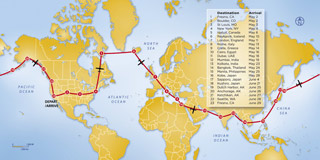 Stops in Italy and Greece were difficult because of weather issues and icing. But Egypt was psychologically the most difficult region. He had received a text from his CFI regarding security warnings for all Americans traveling in Egypt because an American was stabbed outside the embassy. “Hearing that the night before I left was very hard,” Jack said.
Stops in Italy and Greece were difficult because of weather issues and icing. But Egypt was psychologically the most difficult region. He had received a text from his CFI regarding security warnings for all Americans traveling in Egypt because an American was stabbed outside the embassy. “Hearing that the night before I left was very hard,” Jack said.
During the flight from Cairo to Dubai, he was over the Suez Canal, in the dark, and running low on fuel. Talking with Bahrain Control he heard another U.S. airplane say, “What’s a Mooney doing out here by yourself? Did you remember your passport?” The American voice was a comfort and gave him a laugh. In Dubai he rested, staying with a family friend.
Next was the seven-hour flight to India, all over water. “There was no weather radar, which kept me VFR, low, and terrified. ‘Use your training,’ I said to myself again and again.” He descended from 5,000 down to 2,000 feet—steep, spiraling 360-degree turns—and landed at Kolkata. It was not a good landing, and he was shaken. Exhausted, for three days he did not leave the hotel.
He took off for Rayong, Thailand, knowing thunderstorms lurked on this long flight. An eight-hour flight over the South China Sea with a headwind at night to Manila, Philippines, was unnerving.
Jack’s family met him in Kobe, Japan. The family noticed his weight loss, at the time 10 pounds. He did not want to talk about flying, as he felt talking about it was retraumatizing. And after the family left it was the realization that the most difficult and dangerous flying was still ahead.
Questions
Stuck in Sapporo, Japan, because of weather, Jack was in low spirits and wondered if he would be able to complete the journey. There was a daily, constant disappointment with weather, and every morning a go/no-go decision.
After being secluded for nearly four weeks, he flew to Kushiro, Japan. On the verge of tears, he called his girlfriend. “This was the lowest of the lows, the hardest time of all. I only had one ounce of motivation left and the flight that terrified me most was in front of me.”
This last ounce of motivation must have been enough. He departed Japan for Adak, Alaska, an 11-hour flight covering 1,610 nautical miles. He was so nervous he forgot to raise the gear. He was told, “You need to turn around, N432BG.” He talked with Anchorage Center via satellite phone knowing that if he turned around he would have to call it quits; he flew the route VFR.
Weather in Adak was deteriorating. The community was waiting to see him, but playing it safe he diverted to Dutch Harbor. Seeing the sunrise over the northern Pacific Ocean was incredible. Dutch Harbor was Jack’s U.S. reentry; total flight time on that leg was 11 hours, 40 minutes.
Leaving Dutch Harbor, he flew to Anchorage where family and friends greeted him. The now-21-year-old aviator was 20 pounds lighter and counting the days until home.
Almost there
Jack took off for his final destination—Fresno Yosemite International Airport—on June 29. As he flew by Mount Shasta he remembered that in his hardest times he imagined this sight. When he was handed off to Fresno Approach, he exclaimed, “N432BG great to be back with you!” ATC read a proclamation proclaiming June 29, 2013, as Jack Wiegand Day.
“I was on cloud nine. I have actually done this. I was in awe of what I had done.”
Jack landed after two low approaches. Two fire trucks made a water canon archway, which he taxied under to cheers from hundreds. In his eight weeks away and 135.8 hours in flight, Jack Weigand had set a new world record.
Jolie Lucas is a co-founder of the Mooney Ambassadors and Friends of Oceano Airport. She is a private pilot and licensed clinical social worker.
This month on the AOPA Jay
“The Mini Route”
When a friend calls you for a ride from Santa Monica, California, to Hawthorne in your Piper Tri-Pacer, you’re happy to oblige. With a huge pile-up on the 405 freeway, the 15-mile drive would take him hours.
The shortest route from Santa Monica (SMO) to Hawthorne (HHR) is right over the top of Los Angeles International Airport (LAX) via the “Mini Route” Class B transition. It’s a quick 20-minute flight, but you’ll have your hands full.
As you pass above the jets landing and departing at Los Angeles, you’ll put your VFR navigation and communication skills to the test. Your passenger has flown the Mini Route many times, however, and he’ll walk you through the procedure.
Don’t have your AOPA Jay yet? Find out more online.
Aerial adventures: Thunder in the mist
Flying over Niagara Falls
By Jill W. Tallman
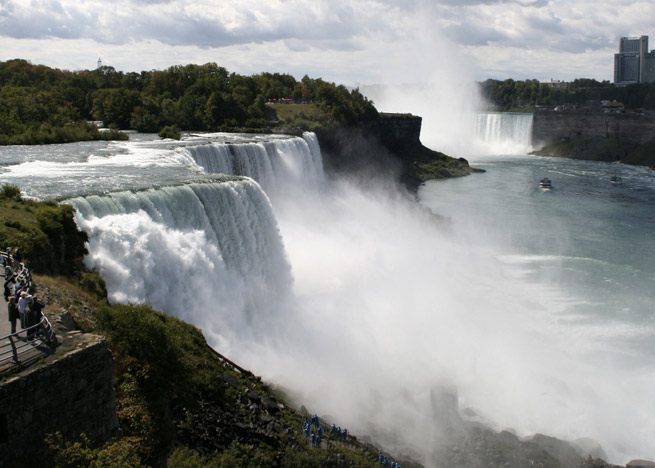
Exactly how impressive can a landmark be when it’s viewed from 3,500 feet msl? When you’re talking about 750,000 gallons of water per second rocketing over the Niagara Falls to plunge hundreds of feet, it’s pretty impressive.
The falls—three separate waterfalls, to be precise—are in a restricted area. You must follow designated procedures, announce your position on a common traffic advisory frequency, and maintain 3,500 feet msl, all while keeping a very sharp eye out for other traffic. Numerous commercial air tours operate within the vicinity below 3,500 feet.
The procedures—which involve flying a sort of clockwise holding pattern near the falls—and a handy diagram can be found in the Airport/Facilities Directory (see “What You’ll See,” below).
Located just a few miles from the falls, Niagara Falls International Airport (IAG) is a good reference point, assuming you do not plan to land there first. You’ll need to use the airport’s altimeter setting when flying the pattern.
It sounds complicated, but it really isn’t. And, if you should happen to forget your diagram, Calspan Air Services at IAG keeps photocopies on hand, as well as a stack of brochures for tour options if you should decide you’d like to experience the falls from sea level.
JetBoat Niagara (www.whirlpooljet.com) got a personal thumbs-up from a Calspan employee, with the qualifying advice, “Bring a change of clothes.”
Email [email protected]
What you’ll see
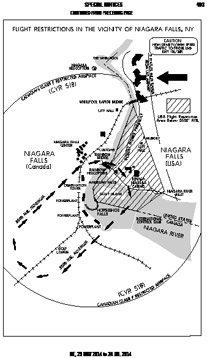 Departing IAG, head southwest about 5 nm, climbing to 3,500 feet msl. Look for the triangular Navy Island, turn to a heading of about 231 degrees, and proceed to the railway yard.
Departing IAG, head southwest about 5 nm, climbing to 3,500 feet msl. Look for the triangular Navy Island, turn to a heading of about 231 degrees, and proceed to the railway yard.
Turn clockwise to a heading of about 51 degrees. The falls will be on your right. Keep an eye out for Goat Island in the Niagara River on the United States side. It is in the middle of the falls.
Even from 3,500 feet,the falls are majestic—particularly when the sun catches the thundering mist and presents you with a rainbow.
Go no farther north than Paradise Bridge, just past the falls. Turn clockwise and don’t forget to announce your position on 122.05 MHz. Repeat.
What local pilots know
IAG has multiple closed taxiways. Bring a current airport diagram.
Fuel is expensive at IAG (we paid $7.07 per gallon for full service 100LL in May), and it’s even higher at Buffalo Niagara International Airport.
Weekends mean more sightseeing and more aircraft to see and avoid. Arrange for a weekday trip if possible.
Video Extra : View the falls in this video.
Space shuttle carrier 747 enters tourism business
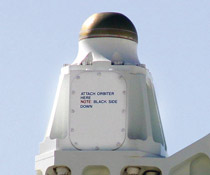 Space Center Houston is building a $12 million complex to house the oldest space shuttle carrier 747, complete with a mockup space shuttle on top. It will also serve as a center for educational programs.
Space Center Houston is building a $12 million complex to house the oldest space shuttle carrier 747, complete with a mockup space shuttle on top. It will also serve as a center for educational programs.
Scheduled to open in February 2015, it will feature access to the inside of the 747 and the full-scale model of the shuttle that once was on display in Florida. The shuttle will be 60 feet above the ground once it is mounted on the 747. Boeing’s “go team” that normally repairs aircraft in service took the 747 apart for its move eight miles from Ellington Airport to Space Center Houston.
Space Center Houston officials have reached half the funding goal and are asking the public for donations. Learn more online (spacecenter.org/the-shuttle-and-747-carrier).
Education programs include school visits, distance learning programs, Scout camp-ins, day camps, and education programs for teachers.
Boeing 747 space shuttle carriers thrilled millions who saw them fly with a space shuttle on top.
Since opening in 1992, Space Center Houston has received more than 16 million visitors and currently hosts nearly 800,000 guests annually in its 183,000-square-foot educational entertainment complex.
NASA operated two space shuttle carriers modified from Boeing 747-100 aircraft. Both had humorous signs printed on the orbiter rear attach point saying, “Attach orbiter here. Note: black side down”
News: Little planes, big speed
Records set at Mojave
By Alton K. Marsh
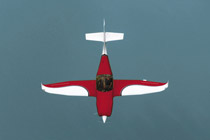 Several new speed records were set during this year’s Mojave Experimental Fly-In in April. Mike Patey of Spanish Fork, Utah, put a 650-horsepower, eight-cylinder Lycoming 780 on his two-seat Lancair Legacy and broke the existing 1,000-kilometer (539 nautical miles) speed record with a speed of 319 miles an hour. The previous record set in 1975 was 300.9 miles an hour. Then he made another flight and broke the 2,000 kilometer (1,079 nm) speed record with, again, 319 miles an hour. The previous record of 256.9 miles an hour was set in 1994.
Several new speed records were set during this year’s Mojave Experimental Fly-In in April. Mike Patey of Spanish Fork, Utah, put a 650-horsepower, eight-cylinder Lycoming 780 on his two-seat Lancair Legacy and broke the existing 1,000-kilometer (539 nautical miles) speed record with a speed of 319 miles an hour. The previous record set in 1975 was 300.9 miles an hour. Then he made another flight and broke the 2,000 kilometer (1,079 nm) speed record with, again, 319 miles an hour. The previous record of 256.9 miles an hour was set in 1994.
In previous years Patey and his twin brother, Mark, broke a San Diego to Jacksonville, Florida, record set by Howard Hughes. They flew wing tip to wing tip and achieved a speed in excess of 300 miles an hour, in six hours and 11 minutes.
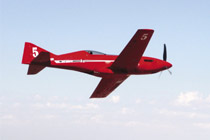 Lee Behel of San Jose, California, set three records in a one-of-a-kind GP–5 racer originally built to race at Reno. It has a highly modified Chevrolet LT 350 engine making 550 horsepower. Behel set a three-kilometer (1.6 nm) record of 377.6 miles per hour, a 15-kilometer (8.1 nm) record of 378.7 miles per hour, and also beat Bruce Bohannon’s time to climb record to 10,000 feetof two minutes and 20 seconds by making the climb in two minutes flat. Bohannon set many time to climb records at Oshkosh and Sun ’n Fun in the Exxon Flyin’ Tiger. Behel decided the only way he could make it was to “zoom climb” the last 1,500 feet, but just as he neared 10,000 feet the nose high angle unported the fuel intake and the engine quit.
Lee Behel of San Jose, California, set three records in a one-of-a-kind GP–5 racer originally built to race at Reno. It has a highly modified Chevrolet LT 350 engine making 550 horsepower. Behel set a three-kilometer (1.6 nm) record of 377.6 miles per hour, a 15-kilometer (8.1 nm) record of 378.7 miles per hour, and also beat Bruce Bohannon’s time to climb record to 10,000 feetof two minutes and 20 seconds by making the climb in two minutes flat. Bohannon set many time to climb records at Oshkosh and Sun ’n Fun in the Exxon Flyin’ Tiger. Behel decided the only way he could make it was to “zoom climb” the last 1,500 feet, but just as he neared 10,000 feet the nose high angle unported the fuel intake and the engine quit.
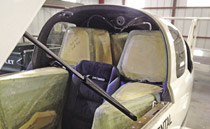 Zach Reeder set a 5,000-kilometer (2,699 nm) record in his aircraft, Burt Rutan’s Catbird, with a speed of 211 miles per hour. He was in the aircraft nearly 16 hours. Reeder, who is an engineer working on the wing for the Paul Allen and Burt Rutan Stratolaunch (world’s biggest airplane), has a deal with Rutan—he gets to fly it and Rutan gets to name the museum it will eventually go to.
Zach Reeder set a 5,000-kilometer (2,699 nm) record in his aircraft, Burt Rutan’s Catbird, with a speed of 211 miles per hour. He was in the aircraft nearly 16 hours. Reeder, who is an engineer working on the wing for the Paul Allen and Burt Rutan Stratolaunch (world’s biggest airplane), has a deal with Rutan—he gets to fly it and Rutan gets to name the museum it will eventually go to.
Plans are to extend the aircraft’s current 6,500-nm range (with four fuel tanks occupying seats intended for passengers) to 7,000 nm and do some aerodynamic tweaking to further increase its range. A 210-horsepower turbocharged Lycoming IO-360 powers it. It is designed to cruise at 200 knots true airspeed.
Email [email protected]
See Mike Patey start his fuel-injected, horizontally opposed 780 engine on YouTube.
Mike Patey is currently working on a hybrid-electric aircraft design.
Zach Reeder used four 200-pound fuel tanks shaped like a reclining person because the Catbird was designed for five 200-pound adults. Catbird normally carries 74 gallons of fuel; with in-cabin tanks it carries 205 gallons. New tanks will be installed to break a nonstop 7,000-nm record.
Flying clubs: Clubs put the C in community
From seven members to 75
By Benét J. Wilson
Marc Epner is a big fan of flying clubs. So big, in fact, that he helped found the Leading Edge Flying Club, based out of Chicago Executive Airport, in 2006. He also worked closely with AOPA to develop the AOPA Flying Club Network, and has participated in several flying club webinars.
“A group of seven decided to start the club because we felt something was missing from our then-current experience. We were at a flight school that had relatively expensive, but very high-quality, late- model aircraft,” said Epner.
So they took the idea of forming a flying club to the owner, but he felt no one would pay $35 a month for the right to fly his airplanes, said Epner. “Our first event, after finding a 2004 glass Archer, was to bring the pilots and spouses together for dinner. It served to set the tone for the organization and our club was started.”
Leading Edge currently has 75 members, who all found the club via word of mouth, said Epner. “Our goal is not to get big, but to bring together like-minded pilots or aviation enthusiasts to share our passion and love for aviation,” he said.
Club events include a monthly breakfast meeting at a local restaurant, an annual thank-you barbecue for the airport community, a holiday dinner, and regular fly-outs. Club members also participate individually in community activities, including Young Eagles and Angel Flight.
People join Leading Edge for its community, which has value, said Epner. “People learn from each other, and you can learn a lot when sitting in the right seat or back seat and not pay for anything other than lunch,” he said. “A flight school provides access, while a flying club provides access and a family and a support structure for getting what you value and want from aviation.”
Email [email protected]
Want to know more?
Resources for starting a flying club or finding one in your area can be found on AOPA online (www.aopa.org/Pilot-Resources/Flying-Clubs.aspx). Included is new tool, “AOPA’s Guide to Starting a Flying Club.”
Pilot products: Audiophiles, listen up
AKG 100 headset review
By Dave Hirschman
 Anyone attempting to break into the crowded market for high-end aviation headsets faces daunting obstacles. Several well established brands with excellent products and customer service networks are firmly in place—and the price ceiling seems solid, too, with an upper limit just north of $1,000.
Anyone attempting to break into the crowded market for high-end aviation headsets faces daunting obstacles. Several well established brands with excellent products and customer service networks are firmly in place—and the price ceiling seems solid, too, with an upper limit just north of $1,000.
But AKG, an Austrian firm with a 66-year history of producing top-of-the-line audio systems for music studios, recording artists, and the automotive industry believes it has an answer with the AKG AV100, the company’s first aviation headset.
“We have aviators on our engineering team and upper management, and they have access to extraordinary resources and knowledge,” said Kent Iverson, AKG’s director of marketing and product development. “We spent three years developing a completely new product.”
The AKG AV100 is light, sturdy, and cleverly designed with smart features such as map lights built into the ear cups, and both a six-pin panel power connection and traditional two-prong plugs in every headset. AKG says its product is measurably quieter than any other aviation headset, and it asks a premium price of $1,099.
I had the opportunity to fly with an AKG AV100 in several general aviation cockpits and found the company’s claims mostly well founded. The headset’s appearance is terrific with a burnished steel band, and it’s exceptionally light, comfortable, and smartly engineered. The quality of music through Bluetooth is far superior to anything I’ve ever heard—or ever expected to hear—in a cockpit.
But I found the AKG AV100 noise cancelling less effective for some kinds of sound than Bose (A20, $1,095) or Lightspeed (Zulu, $850) models. Wind and other high-pitched sounds were just more prominent while wearing the AKG model.
Once I paired the headset to an iPhone via Bluetooth, cranked up the volume, and luxuriated in Beethoven’s Ode to Joy, all other sounds were drowned out, and the music just seemed right for a headset designed in Vienna. (Ludwig van Beethoven’s Ninth Symphony—of which Ode to Joy is the finale—debuted in Vienna in 1824.)
The AKG headset comes in a complete package that includes a carrying case, replacement mic muff, stereo analog cable, and a pair of AA batteries. (Battery life is estimated at 10 hours with all features running and 40 hours with just noise cancelling.)
The AKG AV100 is a serious contender in the ferociously competitive high-end headset market. Audiophiles willing to pay a premium for studio-quality sound when they fly will be blown away by the resonant tones coming through their headphones.
Email [email protected]
Likes
• Built-in LED lights for reading map
• Outstanding music quality via Bluetooth
• Light, comfortable, and thoughtfully engineered
Dislikes
• Noise cancelling doesn’t seem as effective as Bose or Lightspeed


